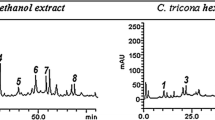Abstract
The present study was carried out to characterize the cellular antioxidant effect of the aqueous extract of Crataegus azarolus and its antigenotoxic potential using human myelogenous cells, K562. The antioxidant capacity of this extract was evaluated by determining its cellular antioxidant activity (CAA) in K562 cells. Also, preceding antigenotoxicity assessment, its eventual genotoxicity property was investigated by evaluating its capacity to induce the DNA degradation of treated cell nuclei. As no genotoxicity was detected at different exposure times, its ability to protect cell DNA against H2O2 oxidative effect was investigated, using the “comet assay.” It appears that 800 μg/mL of extract inhibited the genotoxicity induced by H2O2 with a rate of 41.30 %, after 4 h of incubation. In addition, this extract revealed a significant cellular antioxidant capacity against the reactive oxygen species in K562 cells.




Similar content being viewed by others
References
Barnes, J., Anderson, L. A., & Phillipson, J. D. (2002). Herbal Medicines 2002. London: Pharmaceutical Press.
Bahorun, T., Aumjaud, E., Ramphul, H., Rycha, M., Luximon-Ramma, A., Trotin, F., et al. (2003). Phenolic constituents and antioxidant capacities of Crataegus monogyna (Hawthorn) callus extracts. Nahrung, 47, 191–198.
Chang, Q., Zuo, Z., Harrison, F., & Chow, M. S. (2002). Hawthorn. Journal of Clinical Pharmacology, 42, 605–612.
Pottier-Alapetite, G. (1979). Flore de la Tunisia: Angiospermes, Dicotyledones, Apetales, Dialypetales. Tunis: Ministère de L'Enseignement Supérieur et de la Recherche Scientifique et Ministère de l'Agriculture.
Boukef, M.K. (1986). Les plantes dans la médecine traditionnelle tunisienne, médecine traditionnelle et pharmacopée. Paris: Agence de Coopération Culturelle et Technique.
Aruoma, O. I. (1999). Antioxidant action of plant foods: use of oxidative DNA damage as a tool for studying antioxidant efficacy. Free Radical Research, 30, 419–427.
Edwards, J. E., Brown, P. N., Talent, N., Dickinson, T. A., & Shipley, P. R. (2012). A review of the chemistry of the genus Crataegus. Phytochemistry, 79, 5–26.
Scassellati-Sforzolini, G., Villarini, M., Moretti, M., Marcarelli, M., Pasquini, R., Fatigoni, C., et al. (1999). Antigenotoxic properties of Terminalia arjuna bark extracts. Journal of Environmental Pathology, Toxicology and Oncology, 18, 119–125.
Collins, A. R., Dusinska, M., Gedik, C. M., & Stetina, R. (1996). Oxidative damage to DNA: do we have a reliable biomarker? Environmental Health Perspectives, 104, 465–469.
Wolfe, K. L., & Liu, R. H. (2007). Cellular antioxidant activity (CAA) assay for assessing antioxidants, foods, and dietary supplements. Journal of Agricultural and Food Chemistry, 55, 8896–8907.
Limem-Ben Amor, I., Skandrani, I., Boubaker, J., Ben Sghaier, M., Neffati, M. A., Bhouri, W., et al. (2009). Investigation of biological activity of polar extracts isolated from Phlomis crinita Cav ssp. mauritanica Munby. Drug and Chemical Toxicology, 32, 38–46.
Skandrani, I., Boubaker, J., Bouhlel, I., Limem, I., Ghedira, K., & Chekir-Ghedira, L. (2010). Leaf and root extracts of Moricandia arvensis protect against DNA damage in human lymphoblast cell K562 and enhance antioxidant activity. Environmental Toxicology and Pharmacology, 30, 61–67.
Ben Sghaier, M., Harizi, H., Louhichi, T., Krifa, M., Ghedira, K., & Chekir-Ghedira, L. (2011). Anti-inflammatory and antiulcerogenic activities of leaf extracts and sesquiterpene from Teucrium ramosissimum (Lamiaceae). Immunopharmacology and Immunotoxicology, 33, 656–662.
Krifa, M., Bouhlel, I., Ghedira-Chekir, L., & Ghedira, K. (2013). Immunomodulatory and cellular anti-oxidant activities of an aqueous extract of Limoniastrum guyonianum gall. Journal of Ethnopharmacology, 146, 243–249.
Wang, H., Du, Y. J., & Song, H. C. (2010). α-Glucosidase and α-amylase inhibitory activities of guava leaves. Food Chemistry, 123, 6–13.
Piao, M. J., Kang, K. A., Zhang, R., Ko, D. O., Wang, Z. H., You, H. J., et al. (2008). Hyperoside prevents oxidative damage induced by hydrogen peroxide in lung fibroblast cells via an antioxidant effect. Biochimica et Biophysica Acta, 1780, 1448–1457.
Zou, Y., Lu, Y., & Wei, D. (2004). Antioxidant activity of a flavonoid-rich extract of Hypericum perforatum L. in vitro. Journal of Agricultural and Food Chemistry, 52, 5032–5039.
Kaur, P., Kaur, S., Kumar, N., Singh, B., & Kumar, S. (2009). Evaluation of antigenotoxic activity of isoliquiritin apioside from Glycyrrhiza glabra L. Toxicology in Vitro, 23, 680–686.
Kumar, A., & Chattopadhyay, S. (2006). DNA damage protecting activity and antioxidant potential of pudina extract. Food Chemistry, 100, 1377–1384.
Kun-Young, P., Geun-Ok, J., Kyung-Tae, L., Jongwon, C., Moo-Young, C., Gab-Tar, K., et al. (2004). Antimutagenic activity of flavonoids from the heartwood of Rhus verniciflua. Journal of Ethnopharmacology, 90, 73–79.
Conflict of Interest
No conflict of interest is declared.
Author information
Authors and Affiliations
Corresponding author
Rights and permissions
About this article
Cite this article
Mustapha, N., Bouhlel, I., Chaabane, F. et al. Aqueous Extract of Crataegus azarolus Protects Against DNA Damage in Human Lymphoblast Cell K562 and Enhances Antioxidant Activity. Appl Biochem Biotechnol 172, 2266–2275 (2014). https://doi.org/10.1007/s12010-013-0667-3
Received:
Accepted:
Published:
Issue Date:
DOI: https://doi.org/10.1007/s12010-013-0667-3




